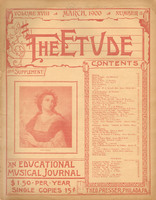Before taking up the subject of technic (in the next issue of The Etude), let us first get rid of the idea that violin technic is confined to that particular work which the left hand is called upon to perform. Musically speaking, technic is “all that relates to the mechanical part of vocal or instrumental performance.” It is the sum-total—the grand result—of purely mechanical effort. Thus, in violin-playing there is necessarily a left- and right- hand technic, either one of which would prove utterly useless if unaccompanied by the other. The student, therefore, who subordinates the work of the right arm, devoting his time and effort chiefly to the acquirement of digital skill, labors in a field absolutely barren of artistic possibilities. Yet, there exists, today, wide-spread ignorance of this fact; and the experienced pedagogue finds everywhere in the student-world an unhealthy striving after left-hand technic—a striving which neither recognizes the subtle difficulties of wrist-technics nor seeks to place the work of the right arm on a plane of importance equal or superior to that of the left hand.
This misapprehension of the higher needs for good bowing may be due, in part, to the superficial treatment which the subject too generally receives; but the truer source of ignorance and misunderstanding of this question is easily traced to the tangibility attaching itself to all work of the left hand,—to the latter’s more apparent requirements and actual achievements. In other words, the young violinist, from the very beginning of his studies, and because of the nature of the various demands which are necessarily made upon the left hand, easily concludes that the left hand performs all actual technical work, and that the bow is employed for the chief (if not the sole) purpose of setting the strings in vibration. Sooner or later he discovers the charm and difficulty of an almost endless variety of bowings; but this does not seem materially to increase appreciation of the true obstacles to artistic achievement. Often, perplexed by his inability to reproduce that which he so clearly conceives, he attributes his inefficiency to some undiscovered weakness of the left hand. Groping blindly and in the wrong direction to ascertain the precise nature and degree of such difficulty, his efforts and experiments are necessarily fruitless. Only after he has arrived at a fair appreciation of the serious import of right-arm technic does he truly begin to expand his art. Only then does he begin to assail the numerous technical problems that confront him daily, with fruitful vigor and intelligence. Then, and then only, does technic attain for him broader and nobler usefulness, and, in its completeness and higher meaning, enable him to achieve something worthy the name of art.



